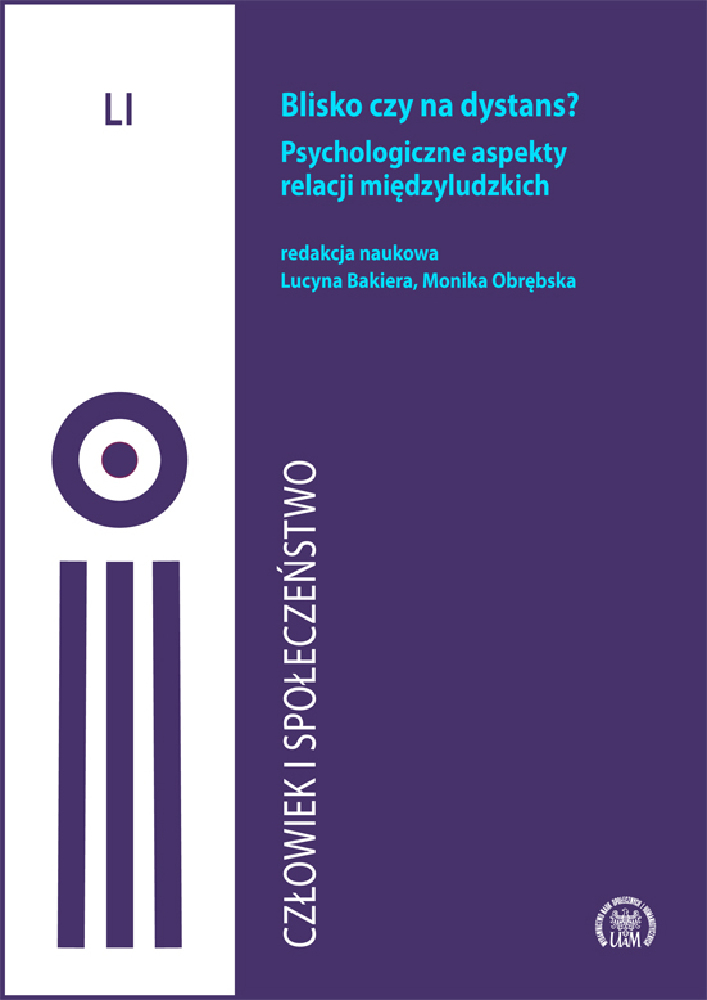Abstract
This article analyses the components of love and the stages of a love relationship in relation to the increasingly common phenomenon of divorce in society. The author underlines that the reason of filing for divorce may be the further development of love and – more specifically – the decline of passion and intimacy, of which the spouses may not be aware. Qualitative changes in love surprise the spouses and cause dissatisfaction. The availability and popularity of divorces, in turn, induce the spouses to resort to such tools. According to the author, an increase in the social awareness in this matter could make it possible to avoid many divorce processes.
References
Błażek, M., Kaźmierczak, M. (2011). The role of spouses’ personality and values systems in marriage: Intercorrelations, satisfaction predictors, and a problem of partner’s similarity. Polish Journal of Social Science, 6(1), 147–168.
Błażek, M., Lewandowska-Walter, A. (2017). Rozwód jako proces. Warszawa: Difin.
Rocznik Demograficzny (2020). GUS. https://stat.gov.pl/download/gfx/portalinformacyjny/pl/defaultaktualnosci/5515/3/14/1/rocznik_demograficzny_2020.pdf (dostęp: 6.05.2021).
Huston, T.L., Caughlin, J.P., Houts, R.M., Smith, S.E., George, L.J. (2001). The connubial crucible: Newlywed years as predictors of material delight, distress, and divorce. Journal of Personality and Social Psychology, 80(2), 237–252.
Levin, J. (2000). A prolegomenon to an epidemiology of love: Theory, measurement and health outcomes. Journal of Social and Clinical Psychology, 19(1), 117–136.
Myers, D.G. (2004). Bliskie związki a jakość życia. W: J. Czapiński (red.), Psychologia pozytywna. Nauka o szczęściu, zdrowiu, sile i cnotach człowieka (ss. 204–254). Warszawa: Wydawnictwo Naukowe PWN.
Roberts, B.W., Del Vecchio, W.F. (2000). The rank-order consistency of personality traits from childhood to old age: A quantitative review of longitudinal studies. Psychological Bulletin, 126(1), 3–25.
Rogge, R.D., Bradbury, T.N., Hahlweg, K., Engl, J., Thurmaier, F. (2006). Predicting marital distress and dissolution: Refining the two-factor hypothesis. Journal of Family Psychology, 20(1), 156–159.
Rosset, E. (1986). Rozwody. Warszawa: Państwowe Wydawnictwo Ekonomiczne.
Rostowski, J. (1987). Zarys psychologii małżeństwa. Warszawa: Państwowe Wydawnictwo Naukowe.
Rostowski, J., Rostowska, T. (2014). Małżeństwo i miłość. Kontekst psychologiczny i neuro-psychologiczny. Warszawa: Difin.
Rydzewski, P. (1991). Przyczyny rozwodów. Ruch Prawniczy, Ekonomiczny i Socjologiczny, 53(4), 235–245.
Solomon, B.C., Jackson, J.J. (2014). Why do personality traits predict divorce? Multiple pathways through satisfaction. Journal of Personality and Social Psychology, 106(6), 978–996.
Sternberg, R.J. (1986). A triangular theory of love. Psychological Review, 93(2), 119–135.
Sternberg, R.J. (1997). Construct validation of a triangular love scale. European Journal of Social Psychology, 27(3), 313–335.
Szlendak, T. (2010). Socjologia rodziny. Ewolucja, historia, zróżnicowanie. Warszawa: Wydawnictwo Naukowe PWN.
Wojciszke, B. (2018). Psychologia miłości. Gdańsk: Gdańskie Wydawnictwo Psychologiczne.
License
1. W momencie złożenia pracy celem rozpoczęcia postępowania w sprawie publikacji, Licencjodawca, zwany dalej Autorem, akceptuje wszystkie zasady umieszczone na stronie internetowej czasopisma “Człowiek i Społeczeństwo”, udzielając Licencjobiorcy, zwanego dalej Wydawcą, niewyłącznej i nieodpłatnej licencji na korzystanie z Utworu. Licencja zakłada tym samym brak ograniczeń terytorialnych, czasowych oraz ilościowych na następujących polach eksploatacji (art. 50 ustawy z dnia 4 lutego 1994 r. o prawie autorskim i prawach pokrewnych):
a. utrwalanie Utworu;
b. zwielokrotnienie Utworu drukiem i w wersji cyfrowej;
c. wprowadzenie do obrotu, użyczenie lub najem oryginału/zwielokrotnionych egzemplarzy Utworu;
d. publiczne wykonanie, wystawienie, wyświetlenie, odtworzenie oraz nadawanie i reemitowanie, a także publiczne udostępnianie Utworu w taki sposób, aby każdy mógł mieć do niego dostęp w miejscu i w czasie przez siebie wybranym;
e. włączenie Utworu w skład utworu zbiorowego;
f. wprowadzenie Utworu w postaci elektronicznej na platformy elektroniczne lub inne wprowadzenie Utworu w postaci elektronicznej do Internetu, Intranetu, Extranetu lub innej sieci;
g. rozpowszechnianie Utworu w wersji elektronicznej w Internecie, Intranecie, Extranecie lub innej sieci, w pracy zbiorowej, a także samodzielnie w formule Open Access w oparciu o licencję Creative Commons Uznanie autorstwa 4.0 Międzynarodowa Licencja Publiczna (CC BY 4.0), a także inną wersję językową tej licencji, lub którąkolwiek późniejszą wersję tej licencji.
2. Założenia licencji Creative Commons Uznanie autorstwa 4.0 Międzynarodowa Licencja Publiczna (CC BY 4.0), udzielają Wydawcy upoważnienia do kopiowania, zmieniania, rozprowadzania, przedstawiania i wykonywania Utworu jedynie pod warunkiem uznania autorstwa.
3. Wraz z dostarczeniem Utworu, Autor zobowiązuje się do wypełnienia, podpisania oraz odesłania skanu umowy
